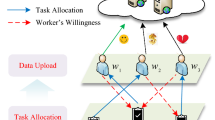Abstract
The performance of various recommendation algorithms is getting stronger and stronger, which also brings new social problems and group polarization. The recommendation algorithm creates a user’s selective access to information, and the continuous iteration of the algorithm and the continuous enhancement of selective information access also lead to the echo chamber effect. To re-apply the collaborative filtering algorithm in polarized crowds and eliminate its echo chamber effect, a collaborative filtering algorithm adapted to polarized crowds is proposed in this paper. The algorithm can determine whether the user is a polarized crowd by using user characteristic information and user behavior information and make collaborative filtering that adapts to the polarized crowd. Specifically, the concept of “polarization fraction” proposed in this paper is a specific score calculated by weighting user characteristic information and user behavior information, and the score is compared with a given threshold to determine whether the user is a polarized crowd. For the polarized population, the user characteristic information and user behavior information are processed by word2vec to get the dangerous word and converted the data from floating-point values to dense vectors and k-means clustering them. After clustering, calculate the distance between the cluster center and the dangerous word vector, which is less than the given threshold, and delete the cluster. For evaluation, two real data-sets ml-latest and ml-1m were tested. The experimental results show that the algorithm can better adapt to the polarized population and has good performance.

















Similar content being viewed by others
References
Shi Y (2019) Research on personalized recommendation system based on big data. Telecom World 26(4):81–82
Zhang H, Hou Y, Tao (2018) A collaborative filtering algorithm based on two-stage joint hashing. Comput Eng 44(12):316–320
Liu T-Y, et al. (2009) Learning to rank for information retrieval. Foundations and Trends®; in Information Retrieval 3(3):225– 331
Shi Y, Karatzoglou A, Baltrunas L, Larson M, Hanjalic A (2013) xclimf: optimizing expected reciprocal rank for data with multiple levels of relevance. In: Proceedings of the 7th ACM conference on Recommender systems, pp 431–434
Shi Y, Karatzoglou A, Baltrunas L, Larson M, Oliver N, Hanjalic A (2012) Climf: learning to maximize reciprocal rank with collaborative less-is-more filtering. In: Proceedings of the sixth ACM conference on Recommender systems, pp 139– 146
Shi Y, Larson M, Hanjalic A (2010) List-wise learning to rank with matrix factorization for collaborative filtering. In: Proceedings of the fourth ACM conference on Recommender systems, pp 269–272
Yang B, Lei Y, Liu J, Li W (2016) Social collaborative filtering by trust. IEEE transactions on pattern analysis and machine intelligence 39(8):1633–1647
Liu N N, Zhao M, Yang Q (2009) Probabilistic latent preference analysis for collaborative filtering. In: Proceedings of the 18th ACM conference on Information and knowledge management, pp 759–766
Zhao L, Lu Z, Pan S J, Yang Q (2016) Matrix factorization+ for movie recommendation.. In: IJCAI, pp 3945–3951
Mnih A, Salakhutdinov R R (2008) Probabilistic matrix factorization. In: Advances in neural information processing systems, pp 1257–1264
Yang W, Jin Z (2018) The research on collaborative filtering algorithm based on clustering. School of Computer and Information 14(16):185–188
Ni W, Sun J (2019) The phenomenon and resolution of “passive” group polarization driven by the recommendation algorithm. Youth Journalist 31:43–45
Yu C (2019) The 44th china statistical report on internet development, Civil-Military Integration on Cyberspace, 9, 81–85
Flint L N (1925) The conscience of the newspaper: A case book in the principles and problems of journalism. D. Appleton
Du S, Gregory S (2016) The echo chamber effect in twitter: does community polarization increase?. In: International Workshop on Complex Networks and their Applications, Springer, pp 373–378
Wang H, Shi X, Yeung D-Y (2015) Relational stacked denoising autoencoder for tag recommendation. In: Twenty-ninth AAAI conference on artificial intelligence
Zou F, Xu R (2002) Multi-model comprehensive evaluation of software reliability. Journal of Tongji University 30(10):1183–1185
Rumelhart D E, Hinton G E, Williams R J (1986) Learning representations by back-propagating errors. nature 323(6088):533–536
Huang G-B, Zhu Q-Y, Siew C-K (2006) Extreme learning machine: theory and applications. Neurocomputing 70(1-3):489–501
Zhou B, Li F, Hou W (2019) Dominant set fuzzy clustering ensemble based on cluster filtering. Computers & Internet 45(07):61–64
Ma H, Yang H, Lyu M R, King I (2008) Sorec: social recommendation using probabilistic matrix factorization. In: Proceedings of the 17th ACM conference on Information and knowledge management, pp 931–940
Chen K, Panpan H, Jian W (2013) User clustering based heterogeneous social network recommendation algorithm. Chinese Journal of Computers 36(2):349–359
Krzywicki A, Wobcke W, Cai X, Mahidadia A, Bain M, Compton P, Kim Y S (2010) Interaction-based collaborative filtering methods for recommendation in online dating. In: International Conference on Web Information Systems Engineering, Springer, pp 342–356
Chen L, Nayak R, Xu Y (2011) A recommendation method for online dating networks based on social relations and demographic information. In: 2011 International Conference on Advances in Social Networks Analysis and Mining, IEEE, pp 407–411
Hitsch G J, Hortaçsu A, Ariely D (2010) Matching and sorting in online dating. Am Econ Rev 100(1):130–63
Li K, Zhang B, Chen F, Tang Y (2020) Learning of several recommendation algorithmsxc, Modern Marketing (Business Edition), 89
Pan L, Zhang D, Li H (2018) Research on user-based collaborative filtering (usercf) news recommendation algorithm. Journal of Shanxi Normal University (Natural Science edition) 32(4):26–30
Lu H, Shi Z, Liu Z (2019) A collaborative filtering recommendation algorithm that integrates user interest and rating differences, Computer Engineering and Applications, 1–8
Acknowledgements
This work is supported by the National Natural Science Foundation of China under grant 61972207, U1836208, U1836110, 61672290; the Major Program of the National Social Science Fund of China under Grant No. 17ZDA092, by the National Key R&D Program of China under grant 2018YFB1003205; by the Collaborative Innovation Center of Atmospheric Environment and Equipment Technology (CICAEET) fund, China; by the Priority Academic Program Development of Jiangsu Higher Education Institutions (PAPD) fund.
Author information
Authors and Affiliations
Corresponding author
Additional information
Publisher’s Note
Springer Nature remains neutral with regard to jurisdictional claims in published maps and institutional affiliations.
Rights and permissions
About this article
Cite this article
Wang, B., Zhao, P., Huang, M. et al. An Improved Recommendation Algorithm For Polarized Population. Mobile Netw Appl 28, 460–472 (2023). https://doi.org/10.1007/s11036-022-01956-0
Accepted:
Published:
Issue Date:
DOI: https://doi.org/10.1007/s11036-022-01956-0




